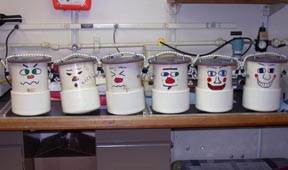January 30, 2004
The long transit down to the dive area on the East Pacific Rise (EPR) provides an opportunity for the various science groups to look at the wealth of geologic and geophysical information previously collected at the EPR on expeditions spanning over a decade. This information provides the background that allows the scientists to determine the optimal locations for Alvin dives during the daytime and various experiments to be performed at night. The TowCam developed by Dan Fornari and numerous engineers at WHOI, is unique in that it includes a high resolution (3.3 megapixel) deep sea digital camera and a strobe system and an ability to sample the volcanic seafloor using small winches and wax coated steel balls. We'll describe these in more detail in a few days.
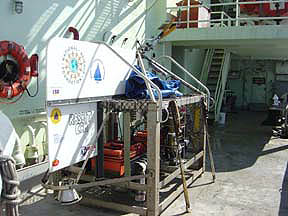 The
WHOI TowCam (AKA Rabbit Cam) on the starboard side of the Main Deck on
R/V Atlantis.
The
WHOI TowCam (AKA Rabbit Cam) on the starboard side of the Main Deck on
R/V Atlantis.
The TowCam is lowered from the side of the ship on a conducting cable and “flown” remotely from the R/V Atlantis, approximately 5 meters above the seafloor, while the ship moves forward at about a half knot. The purpose of the camera system is to provide a high resolution photo mosaic of the seafloor that will initially help determine the location of future Alvin dives and for future research studies. Eight 8 pound steel balls with wax coatings are carried on the TowCam. These balls are triggered from the ship at desired intervals to drop onto the seafloor, bash into the glassy lava surfaces and collect chips of volcanic rock within the wax. The balls are winched, remotely, back into holders in the TowCam sides. This provides a “remote sensing” method of sampling seafloor volcanic rocks for future chemical analysis.
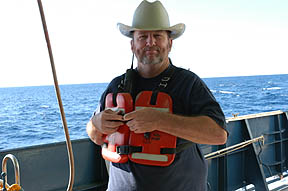 Dave
Sims, one of the shipboard technicians, was in charge of deploying the
TowCam for today's test.
Dave
Sims, one of the shipboard technicians, was in charge of deploying the
TowCam for today's test.
The TowCam was tested this afternoon by lowering the equipment to a depth of 1500 meters and triggering the sampling weights. This also provided the Bill Seyfried and Kang Ding and the U. Minnesota scientists involved in research on hydrothermal vents, with an opportunity to test their probes that will be mounted on Alvin for making temperature and chemical measurements at high and low temperature hydrothermal vents at the EPR.
Tomorrow, we will start training by the pilots for those scientists who will be involved in the Alvin dives.
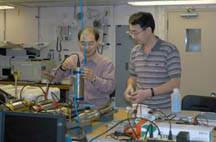 Kang
Ding (right) and Canjun Yang (left) work on the hydrothermal remote sensing
instruments in the Hydro Lab.
Kang
Ding (right) and Canjun Yang (left) work on the hydrothermal remote sensing
instruments in the Hydro Lab.
Javier
Escartin, Mike Perfit and John Maclennan reviewing data in the Main Lab.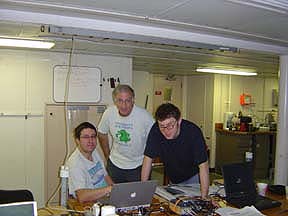
"Weebles"... sample storage containers that are part of an experiment that Stace Beaulieu, Rhian Waller and Tim Shank (their collaborator who is not on this cruise) are conducting. More on this in a future posting...
